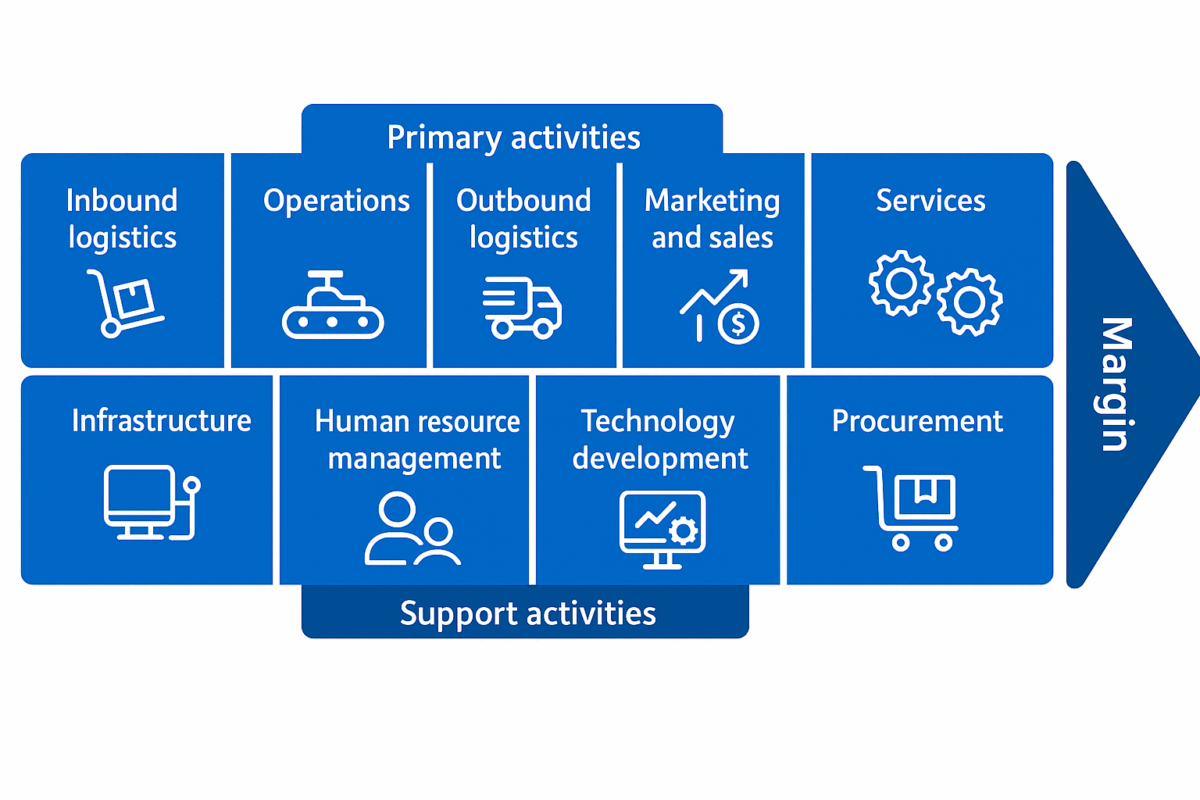
The concept of the value chain we use today began with the representation of an industrial process flow in 1985. Michael Porter may not have realized it at the time, but he was revolutionizing business models through a concept that remains widely applied to this day.
However, even after 40 years since its emergence, many professionals still struggle to apply the value chain in practice. This happens due to several factors, such as the persistence of organizational silos, superficial mapping, among many others.
Although the theory may seem simple at first glance, why are so many organizations still unable to achieve real results from its application?
Let’s break it down: what is the value chain?
According to Porter’s definition, it is a strategic model that analyzes a company’s activities in two categories: primary activities and support activities. This distinction makes it easier to identify how each process contributes to creating value for the customer and for the company as a whole.
From this perspective, it becomes possible to understand how both categories of activities interrelate, optimizing efficiency, reducing costs, and, as a result, building a sustainable competitive advantage and generating greater profit for the business.
This process management tool also describes and analyzes organizational activities from the perspective of value creation for customers, identifying value-adding activities, costs, and opportunities for improvement.
Primary activities are those that directly contribute to the creation and delivery of a product or service, such as Logistics, Operations, Marketing, Sales, and Services. Support activities, on the other hand, are those that provide the foundation for primary activities, ensuring successful delivery to customers, such as Infrastructure, Human Resources Management, Technology Development, and Procurement.

In practice, the value chain brings together all of the company’s processes and organizes them in a functional way, so that this interdependence channels the best of both sets of activities toward a greater purpose: delivering value to customers.
What are the main challenges?
Organizational silos are the main obstacles in this area and, along with other factors, prevent the value chain from generating measurable results.
This happens because the purpose of the value chain is to connect different areas through processes so they flow effectively, whereas silos work in the opposite direction. They structure work independently, creating barriers to team collaboration and hindering communication.
It is as if the departments were competing against each other, even though the sum of their outputs is what ultimately determines the final product or service delivered. This type of culture affects not only the smooth functioning of the value chain but also the work environment, productivity, and process efficiency.
Another critical aspect is that the tool, to be effective, must be applied in depth, requiring thorough analysis and commitment from the teams. Otherwise, it is reduced to an organizational chart or a static flow, impeding the understanding of activities and the identification of true process bottlenecks that hinder progress and positive results.
Superficial mapping can result in missed improvement opportunities, incorrect decision-making, and a disorganized view of processes. While it requires effort, mistakes can lead to losses, making the work done ineffective.
Manual process management also negatively impacts the efficiency of the value chain, as it fragments information and makes real-time monitoring of operations difficult.
Automation, for example, allows organizations to identify and restructure processes that do not add value to the chain overall, creating new opportunities and facilitating the adaptation of processes according to customer requirements and other regulations.
Overcoming these and other specific challenges your organization faces regarding the value chain will ensure better utilization of work resources, secure alignment between strategy and operations—essential for achieving strong results—and improve the efficiency and agility of deliveries in dynamic environments.
Putting Value Chain Theory into Practice
Once again—and it may sound repetitive—the organizational culture will support the necessary change, ensuring that employees feel engaged with the initiative and recognize the strategic potential of the tool. Breaking down organizational silos, for example, stems from changes driven by culture.
Decision-making is another key aspect of translating theory into practice. Clear metrics should be used to evaluate process efficiency, and decisions must be based on such data and derived from reliable information sources.
Finally, using the right technology to digitize the value chain process is considered crucial for successful implementation. Digital transformation in this area helps make the value chain more dynamic, visual, and integrated.
The benefits are extensive, but it is worth highlighting the agility in updates, reduction of bureaucracy, integration of information across different areas, real-time monitoring dashboards, and the identification of continuous improvement opportunities.
Interact Suite SA and the Value Chain
Increasingly focused on connecting methodology with daily organizational practice, Interact has developed the Value Chain solution.
This solution allows you to visualize the full set of activities carried out across a company’s core processes and identify weaknesses in the production chain. Additionally, it enables the evaluation of process efficiency and the discovery of ways to improve them, resulting in even greater value for your customer.
Its features also help optimize the supply chain, assess process efficiency, support cost reduction, ensure visibility of competitive advantage, and offer many other benefits.



